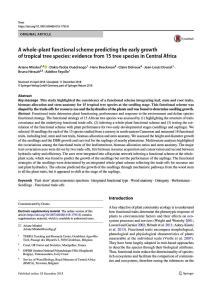Mirabel A., Ouédraogo D.Y., Beeckman H., Delvaux C., Doucet J.L., Hérault B., Fayolle A.
Key message This study highlighted the consistency of a functional scheme integrating leaf, stem and root traits, biomass allocation and stem anatomy for 15 tropical tree species at the seedling stage. This functional scheme was shaped by the trade-offs for resource use and the hydraulics of the plants and was found to determine seedling growth.
Abstract Functional traits determine plant functioning, performance and response to the environment and define species functional strategy. The functional strategy of 15 African tree species was assessed by (1) highlighting the structure of traits covariance and the underlying functional trade-offs, (2) inferring a whole-plant functional scheme and (3) testing the correlation of the functional scheme with plant performance for two early developmental stages (seedlings and saplings). We selected 10 seedlings for each of the 15 species studied from a nursery in south-eastern Cameroon and measured 18 functional traits, including leaf, stem and root traits, biomass allocation and stem anatomy. We assessed the height and diameter growth of the seedlings and the DBH growth and survival for the saplings of nearby plantations. Multivariate analyses highlighted the covariations among the functional traits of the leaf/stem/root, biomass allocation ratios and stem anatomy. The major trait covariation axes were driven by two trade-offs, first between resource acquisition and conservation and second between hydraulic safety and efficiency. The axes were integrated into a Bayesian network inferring a functional scheme at the wholeplant scale, which was found to predict the growth of the seedlings but not the performance of the saplings. The functional strategies of the seedlings were determined by an integrated whole-plant scheme reflecting the trade-offs for resource use and plant hydraulics. The scheme predicted the growth of the seedlings through mechanistic pathways from the wood stem to all the plant traits, but it appeared to shift at the stage of the saplings.
Consultez la notice complète de l’article sur ORBi

